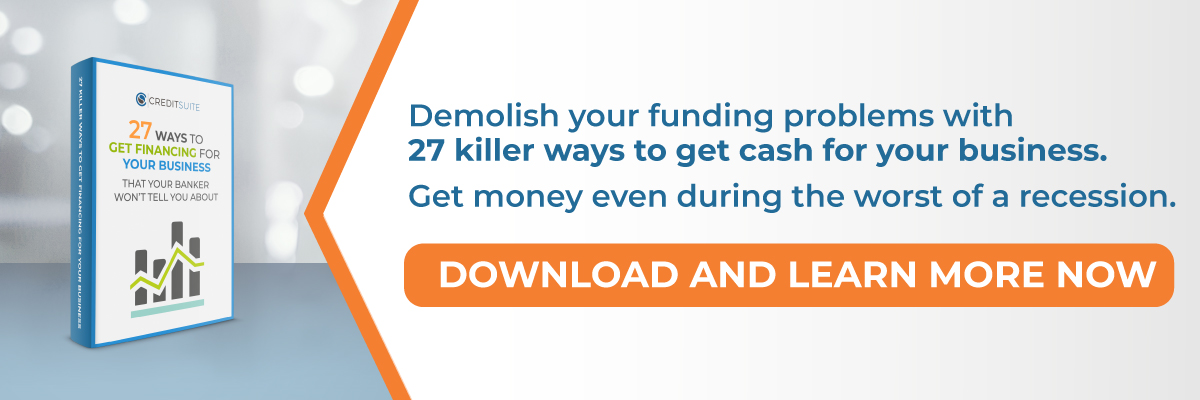
How to Get Merchant Cash Advance Financing for Your Business
Merchant Cash Advance Financing Can Help Your Business
Is merchant cash advance financing on your radar? If you’ve got bad personal credit, or not a lot of time in business, merchant cash advance financing could be your best bet for business financing.
Getting Business Financing
Financing for your business tends to come from one or more of the following types of sources:
- Collateral
- Cash flow
- Leveraging good business and/or personal credit
Two other ways to get financing are:
- Selling off a part of your business
- ‘Freeish’ sources like grants and crowdfunding
With crowdfunding and grants, you’re giving up time and brainpower, rather than collateral or some form of security.
Let’s look at using forms of business collateral. This includes converting your merchant cash advances into business capital.
Using Business Assets as Collateral for Loans
Business collateral can be:
- Merchant cash advances
- Accounts receivable
- Equipment that you own
- A book of business (renewable commissions) if you’re buying an insurance agency
- Inventory
- Commercial real estate
Using Merchant Cash Advances as Collateral for Merchant Cash Advance Financing
Not-yet paid credit card sales authorizations are worth money! MCAs are a response to the fact that you need to wait a bit to get your money. As a result, your wait time is slashed, and you get the benefit of taking credit cards and payments in a fraction of the time.
Net 30 Terms
Net 30 means a company or person you extend credit to will have thirty days to pay the bill in full. Being able to offer your customers a month to pay you back is a real competitive advantage. It could be what sets you apart. But you’ve also set yourself up with a wait of about a month for the money. Merchant cash advance financing can help to fix all that.
How to Get Merchant Cash Advance Financing for Your Business
An MCA technically isn’t a loan (so you can’t truly call it a merchant cash advance loan). Rather, it is a cash advance based on the credit card sales of a business. A small business can apply for an MCA, and have an advance deposited into its account fairly quickly. So you can offer Net 30 terms, but not have to wait a month to get paid.
A merchant financing program is based on your cash flow as verifiable per your business bank statements—and nothing else. Hence merchant cash advance companies in general will not ask for any burdensome document requests.
How do merchant cash advances stack up against other forms of financing?
Business Credit vs. Merchant Cash Advance Financing vs. Cash Flow Financing
With MCAs, merchant cash advance lenders check your credit card sales, and with cash flow financing, they check all of your cash flow. But with business credit, providers will check your business setup, which is why we talk about fundability so much. And once you have a PAYDEX score, they’ll check it as well.
so much. And once you have a PAYDEX score, they’ll check it as well.
With business credit, starter vendors often won’t have a time in business requirement. But retail and business credit card providers tend to. Contrast this with MCAs, where you often need to be in business at least 6 months, and cash flow financing, where you often need to be in business for at least a year.
With cash flow financing, lenders want to see accounts payable and accounts receivable. Lenders want to see your bank statements if you’re trying to get an MCA. But with business credit, starter vendors want to know you will pay them back. So they will check your fundability . This means they will want to see you have an EIN, a D-U-N-S number, all the licensing you need, etc.
. This means they will want to see you have an EIN, a D-U-N-S number, all the licensing you need, etc.
Details
With cash flow financing, paying the loan back depends on future company profits. But business credit doesn’t depend on anything in particular to pay it back. It’s best practices to pay out of your business profits and/or assets. And with merchant cash advances, future payments to the business by customers is the way you’ll pay back the advance.
Get a merchant cash advance, and you won’t have to pay any interest. Your sole fee is to the lender–it’s compensation to them for advancing you the funds. This form of financing can also be interest-free, but only if you pay on time.
If you don’t pay your business credit cards and starter vendor cards on time, then interest rates will vary. In addition, better FICO scores and/or better business credit will garner you better rates. But with cash flow financing, you will be paying interest no matter what.
Your FICO score will matter more for cash flow financing and business credit. With business credit, better FICO scores will help you get better rates, and some providers may require them. Cash flow financing can often require a higher minimum FICO score than for merchant cash advances. And for MCAs, you can usually have a lower minimum FICO score.
Which Form of Business Financing is Best?
You should always be trying to build your business credit. This is so even if you’re going with a different form of business financing. For a newer business, which has been around for at least six months, MCAs can be a way to get fast cash while still offering good terms to your clientele as you build your business.
And for more time in business, if your cash flow is stable, cash flow financing can be another viable option. And there’s no reason you can’t try two of these or even all three. See what works best for your circumstances.
Merchant Cash Advance Financing: Terms and Qualifying
A lender will review 3 months of bank and merchant account statements, to look for consistent deposits. They want to see deposits showing revenue is $50,000 or higher per year. They will also verify time in business of 6 months or more.
Lenders don’t want to see a lot of Non-Sufficient-Funds (NSFs) showing on your bank statements. They don’t want to see a lot of chargebacks on your merchant statements. And they want to see more than 10 deposits in a month going into your bank account. In a nutshell, they want you to manage your bank and merchant accounts responsibly.
Lenders will want to see a decent number of consistent credit card transaction deposits each month. But what a merchant cash advance lender considers to be ‘decent’ is going to vary from lender to lender. And be aware, interest rates for merchant cash advances can be high.
Choosing a Merchant Cash Advance Financing Program
Always look at interest rates. Because MCAs don’t have federal regulation, terms can seem outrageous. Also check if your payment schedule is fixed or if it’s a percentage of credit card sales. A percentage of card sales means your payment goes down if sales falter, but of course they go up if your sales are robust.
And investigate similar programs like not just cash flow financing and business credit, but also invoice factoring, as they might be a better fit. Our Business Finance Suite has MCA providers you can check out, too!
Merchant Cash Advances and Inflation
Inflation causes price increases for goods and services. And it can also affect how you price your own goods and services. Inflation can cut into your profit margin unless you raise your prices.
How can MCAs help?
By getting use of your money faster, an MCA can help you to buy your own goods and services—and even equipment—before it gets pricier. If you’re using the cash from MCAs to pay off loans faster, then speed will help you avoid paying more in interest.
MCAs are also helpful because you get a payment even though you may have charged less. When the customer buys from you again, if you need to raise prices, you aren’t also waiting around for them to pay what they owe you.
Merchant Cash Advance Financing: Takeaways
Merchant cash advances can make it easier and more logical to give net 30 terms to your customers. You can be paid a lot faster, which eliminates the main disadvantage of offering net 30 terms. MCAs are within reach even if you have a lower FICO score. But keep in mind that interest rates can be high.
The post How to Get Merchant Cash Advance Financing for Your Business appeared first on Credit Suite.












